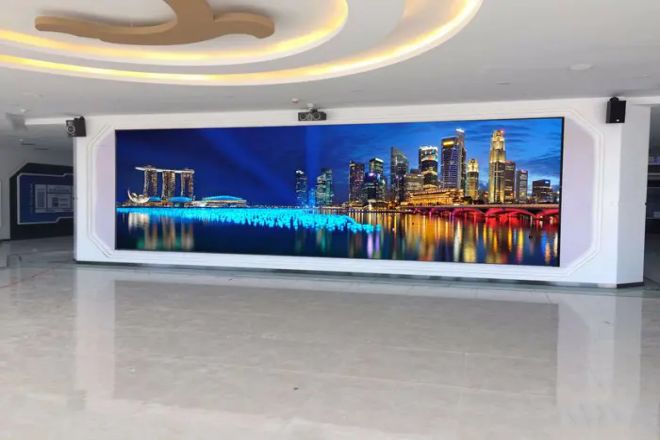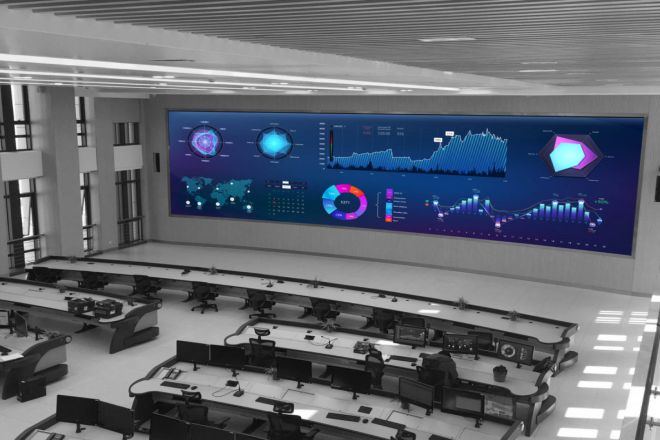Introduction

As an important carrier of modern information display, the LED display screen’s clarity is one of the important indicators to evaluate its performance. Clarity not only determines the delicateness of the display but also directly affects the audience’s visual experience. This article will explore in detail the main factors that affect the clarity of LED displays and help you gain a deeper understanding of this technical field.
1. Definition and importance of LED display clarity
In LED displays, clarity refers to the fineness and sharpness of displayed images or video content. It is usually affected by multiple factors, the core of which is pixel density and color reproduction.
Pixel density, that is, the number of pixels per unit area, is a key indicator that determines the clarity of an LED display. The higher the pixel density, the more pixels can be displayed per unit area, the richer the image details, and the clearer the displayed picture.
Color reproduction refers to the ability of the LED display to restore the original colors when displaying images. A display with high color reproduction can more accurately present the colors of the original image, making the picture more realistic and vivid.
Therefore, the clarity of an LED display is a comprehensive concept that covers many aspects, such as pixel density and color reproduction, which together determine the sophistication and visual effects of the display when presenting images.
Clarity has an important impact on the application effects of LED displays in various scenarios.
First of all, in the field of advertising, the high definition of LED displays can ensure that advertising content is presented in a more detailed and realistic way, attracting the audience’s attention and improving the communication effect of advertising.
Secondly, in conferences, exhibitions, and other occasions, LED displays usually need to display a large amount of text, pictures, and video information. If the clarity of the display is insufficient, the audience may not be able to see the display content clearly, affecting the transmission and communication of information.
In addition, as people have higher and higher requirements for visual experience, high-definition LED displays can provide better visual enjoyment and enhance the audience’s sense of participation and immersion.
Therefore, whether in advertising, conferences, exhibitions, etc., the clarity of an LED display is one of the important indicators for evaluating its performance and is of great significance for improving the display effect and audience experience.
2. Main factors affecting the clarity of LED display

The following is an analysis of the main factors affecting the clarity of LED displays:
1). Pixel spacing and pixel density:
- The concept of pixel pitch and its impact on clarity:
Pixel pitch refers to the distance between adjacent pixels. The smaller the pixel pitch, the closer the distance between pixels, the higher the pixel density of the screen, and the clearer the image. On the contrary, the larger the pixel pitch, the sharper the image will be reduced.
- How pixel density is calculated and its impact on visual effects:
Pixel density refers to the number of pixels per unit area. Generally, the higher the pixel density, the richer the details of the image and the better the visual effect. Therefore, increasing the pixel density can effectively improve the clarity of the LED display.
2). Color performance and color depth:
- The importance of color performance:
Color plays a key role in improving picture clarity and realism. Rich, accurate color performance can make images more vivid and realistic.
- The concept of color depth and its impact on color performance:
Color depth refers to the number of colors that a display can display, usually expressed in bits. The higher the color depth, the richer the displayed colors and the more natural the transition, thereby improving the clarity and realism of the picture.
3). Screen size and viewing distance:
- The impact of screen size on clarity:
Under the same pixel density, the larger the screen size, the more pixels per unit area, and the clarity of the image will increase accordingly. However, excessive screen size results in increased viewing distance, which affects the viewer’s perception of clarity.
- The relationship between viewing distance and clarity:
Viewing distance refers to the distance between the viewer and the display screen. The closer the viewer is to the display, the higher the resolution and clarity requirements. On the contrary, if the viewing distance is farther, the requirements for resolution and clarity will be relatively reduced. Therefore, when choosing an LED display screen, you need to determine the appropriate screen size and resolution based on the actual viewing distance.
4). Display technology and driving methods:
- The development of LED display technology and its impact on clarity:
With the continuous development of LED display technology, its brightness, contrast, color reproduction, and other performances have been significantly improved, thus improving the clarity of LED displays. For example, small-pitch LED technology makes the picture more delicate and clear by reducing the pixel pitch and increasing the pixel density.
- Optimization of driving methods and improvement of clarity:
Optimization of driving methods plays an important role in improving the response speed and color reproduction of LED displays. By optimizing the driving method, the response time of the display can be reduced, and the refresh rate and smoothness of the image can be improved. At the same time, the color restoration can be improved, making the picture more realistic and vivid. These all help to improve the clarity of the LED display.
3. Strategies and methods to improve the clarity of LED display screens
- Choose appropriate pixel spacing and pixel density:
When selecting an LED display, you need to determine the appropriate pixel spacing and pixel density based on the application scenario and viewing distance. Smaller pixel pitches and higher pixel density can lead to higher image clarity but also increase costs. Therefore, the choice needs to be made by taking into account factors such as clarity, cost, and budget.
- Using advanced color correction technology:
Color correction technology can ensure that the colors displayed on the LED display are accurate and improve the realism and clarity of the picture. This includes regular color calibration to ensure color consistency and accuracy and the use of advanced color processing technologies, such as color enhancement, color balance, etc., to improve the color expression and clarity of the picture.
- Adjust the screen size and viewing distance according to the application scenario:
Screen size and viewing distance are important factors affecting the clarity of LED displays. The appropriate screen size and viewing distance need to be selected based on the actual application scenario. For example, in large conference rooms or exhibition venues, you need to choose a larger screen size and an appropriate viewing distance to ensure that the audience can clearly see the screen content.
- Continuously update display technology and optimize driving methods:
With the continuous development of LED display technology, new display technologies and driving methods continue to emerge, providing more possibilities for improving the clarity of LED displays. It is necessary to pay close attention to industry trends and technological developments, update display technology in a timely manner, and optimize driving methods to improve the performance and clarity of LED displays.
- Specific methods include:
Using small-pitch LED technology improves the delicacy and clarity of the picture by reducing the pixel spacing and increasing the pixel density.
Introducing HDR (High Dynamic Range) technology to improve the contrast and color depth of the display, making the picture more realistic and vivid.
Using PWM (Pulse Width Modulation) dimming technology, by quickly adjusting the brightness of the LED, precise control of brightness is achieved, and the uniformity and clarity of the picture are improved.
Optimize the driving method, improve the response speed and refresh rate of the display, reduce picture delay and smear, and improve the viewing experience.
4. How to choose ultra-high-definition LED display

When shopping for an Ultra HD LED display, here are some key considerations to ensure you make an informed purchasing decision:
- Resolution and pixel density:
The first thing to consider is the resolution of the display, with Ultra High Definition (UHD) usually referring to 3840×2160 pixels (4K) or higher. The higher the resolution, the more detailed the image.
Pixel density (PPI) is also very important, as it determines the number of pixels per unit area. A higher PPI means clearer images, especially when viewing at close range.
- Color performance:
The display’s color accuracy, color gamut coverage, and color depth are all key factors. Ensure that the display can accurately reproduce colors, with a wide color gamut and sufficient color depth to present richer color details.
- Brightness and Contrast:
Brightness determines the visibility of the display in bright environments, while contrast affects the layering and detail of the image. Choose the appropriate brightness and contrast according to the application environment (indoor/outdoor).
- Viewing angle:
Make sure the display has a wide viewing angle so viewers can see a clear picture from all angles.
- Display size:
Choose the appropriate display size based on viewing distance and application scenario. A screen that is too large may result in a loss of detail, while a screen that is too small may not meet the viewing needs of the audience.
- Technology and brand:
Consider displays using advanced technologies (such as fine-pitch LED, HDR technology, etc.). Well-known brands usually mean higher quality, better reliability, and better after-sales service.
- Power consumption and efficiency:
Understanding the power consumption and energy efficiency ratio of displays and choosing energy-saving and efficient displays can help reduce operating costs.
- Reliability and Durability:
Consider the durability and reliability of the display, especially its performance in harsh environments or high-load operations.
- Installation and maintenance:
Consider how the display will be installed and what maintenance needs are needed. Choosing displays that are easy to install, maintain, and upgrade can reduce downtime costs.
- Price and Budget:
Choose the right LED display based on your budget range. Note that while pursuing high resolution and excellent performance, cost-effectiveness must also be considered.
- Investigation cases and customer reviews:
Before purchasing, you can check the cases and customer reviews provided by the manufacturer to understand the performance of the display in actual applications and user satisfaction.
- Communicate with suppliers:
Fully communicate with suppliers to understand their product features, technical support, and after-sales services. This will help you make more informed purchasing decisions.
Finally, it is recommended that you conduct on-site inspections and comparisons before purchasing so that you can more intuitively understand the performance and appearance of different brands and models of LED displays.
Conclusion
This article summarizes the factors that influence and improve strategies for the clarity of LED displays and emphasizes that these factors should be fully considered when purchasing and using LED displays to obtain the best display effect and visual experience.
If you want to know more about LED displays, please get in touch with us.
